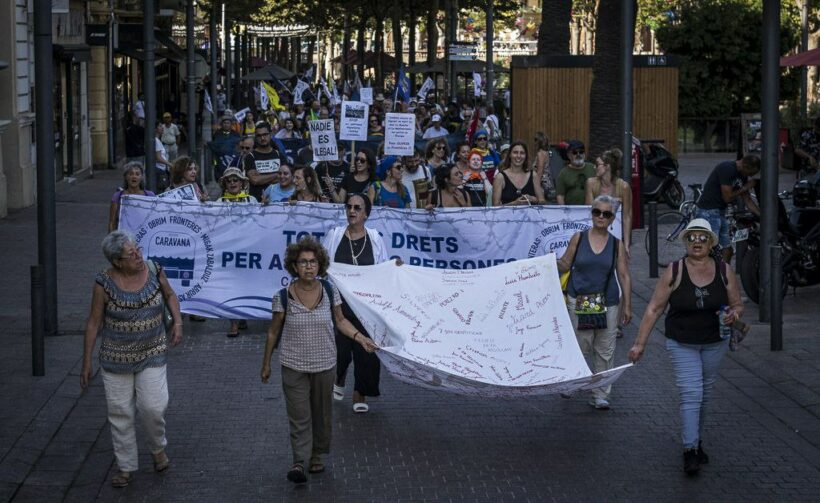The Caravan is moving towards the border migration routes in the Alps after visiting the Irun-Hendaia border and the concentration camps in the south of France that were set up at the end of the 1930s.
The acts in memory of those who in the past and present have lost their lives at the borders have occupied an important place in this first stage of the Pyrenees Alps Caravan.
In Irún, a few metres from the Bidasoa, a monolith was unveiled with the inscriptions of two verses in Basque by the bertsolari Amets Arzallus, author of the book Miñan Hermanito: “In painful memory of the migrants who left their last breath here. Borders that close the way to migrants who open roads”. An aurresku and an emotional remembrance of each of the nine people who have lost their lives on this border in the last year accompanied the event.
In Bielsa, a second tribute was paid to the Republican exiles. Between April and June 1938, the resistance of the 43rd Division enabled more than 5,000 people to be evacuated from Aragon to France and became an example of organisation and solidarity of the Republican fighters and the French people with the people of Aragon.
More than 500,000 people were exiled by the armed conflict of the Civil War as a result of Franco’s military coup and the host country for many of them was France, so “we wanted to offer recognition to all those people, their struggle, their resistance to fascism, their survival in the French and Nazi concentration camps and their struggle to defend the ideals of freedom”.
The migration route of this European solidarity caravan includes a visit to the former concentration camps of Gurs and Rivesaltes, as well as the beach of Argelès, which was the initial destination of many of these exiles. The Basque historian Josu Chueca, author of the book “Gurs, the Basque camp” gave a talk on the living conditions in the camps inside a reconstructed barracks. Built near Oloron in 1939, it held more than 5,000 Republicans, most of them of Basque origin. In 1940 it also confined Jews, gypsies and foreigners, and housed up to 18,000 people, many of whom died because of the difficult conditions, 3907 were transported in lorries to be gassed at Auschwitz-Birkenau.
On the beach at Argelès, the first of 180 camps in the south of France, a meeting took place on Tuesday with descendants of those interned there. “It took 60 years to begin to remember and recognise what happened here. The first events were attended by only one or two people,” said one of them. Today, a monolith and a plaque remind us that many people lived and died on this beach. Hayer Ayachi, a Tunisian mother with a missing son who is travelling in the Caravan, also spoke: “I will continue to build even if others are destroying. I will continue to believe even if others have lost hope.
In the afternoon, the Caravan members visited the Memorial of the Rivesaltes concentration camp where up to 60,000 people of 100 different nationalities were interned in different periods and historical conflicts: Republican exile, the Second World War, decolonisation, etc. It remained open until 2007 as an Administrative Holding Centre for migrants. The construction of the Memorial, inaugurated in 2015, led to its transfer to another location near the airport.
During the tour, meetings and exchanges of experiences have taken place at the different destinations with local groups that defend the rights of people who are forcibly displaced, with whom actions have been carried out to denounce the migration and neo-colonial policies of the European Union and to demand the right to migrate in dignified conditions, because, as the caravanist Aboubakar Aminou said in front of Perpignan City Hall after the anti-racist and anti-fascist demonstration: “If you want to talk about memory, if you want to ask why we come to Europe, first ask yourselves why you came to Africa”.
The Elna Maternity Hospital, where Swiss nurse Elizabeth Eidenbenz delivered more than 500 babies to women from the surrounding camps, was the last stop on the Caravan’s route before continuing on to its new destination, the French-Italian border.










